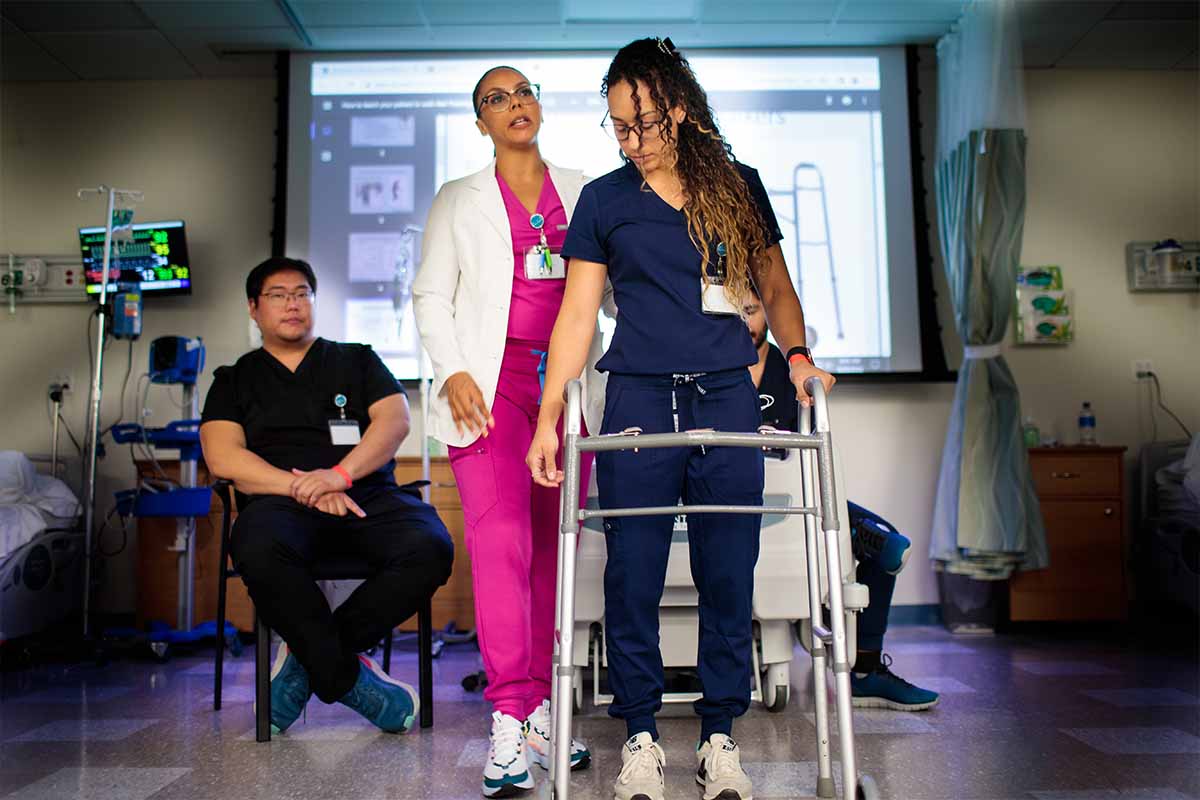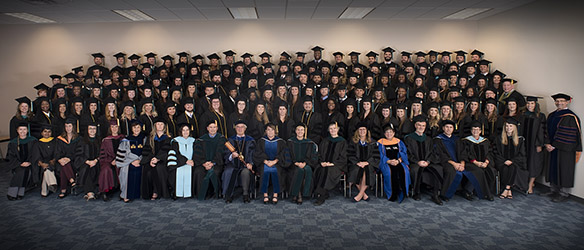
An occupational therapist’s career can be rewarding as it involves helping individuals perform meaningful everyday activities.1 Not only is occupational therapy a rewarding career, it offers a promising salary. As of May 2023, the U.S. employed almost 144,840 occupational therapists who earned an average annual salary of $96,370.2
Considering those benefits and career prospects, how do you become an occupational therapist?
In this post, we walk you through what is required to earn an occupational therapy degree, how long it takes, specialty opportunities and more. With these steps, you’ll know what it takes to launch your career as an exceptional occupational therapist.
Table of Contents:
- What Is Occupational Therapy?
- What Do Occupational Therapists Do?
- What Skills Do You Need to Be an Occupational Therapist?
- What Are the Benefits of Becoming an Occupational Therapist?
- What Are Occupational Therapy Job Opportunities?
- How Much Do Occupational Therapists Make?
- Occupational Therapist Specialty Opportunities
- Five Steps to Become an Occupational Therapist
- How USAHS Can Help You Prepare to Be an Exceptional Occupational Therapist
What Is Occupational Therapy?
Occupational therapists (OTs) use their skills to assist patients with different cognitive or physical conditions that limit their capacity to perform day-to-day activities.1 As an OT, you help patients participate in important activities, or occupations, of daily life.
OTs apply their ingenuity to find customized adaptive movements and technologies that help patients participate more fully in occupations like work, play, leisure, education and social interaction. OTs also work with patients on activities of daily living (ADLs), such as eating, bathing and getting dressed.1
What Do Occupational Therapists Do?
Occupational therapists work with people of all ages with different cognitive and physical capabilities.1 An occupational therapist begins by communicating with the patient, teachers, family or caregivers to better understand their needs.
Next, the occupational therapist assesses the patient’s physical, sensory, emotional and cognitive capacities to develop goals and a treatment plan. From here, the patient and the OT work together to develop and improve skills. While working toward the stated goals, the patient and OT regularly evaluate the patient’s progress.1
The responsibilities of occupational therapy practitioners may include:1
- Helping patients learn new ways to perform ADLs
- Supporting patients in creating a daily routine, learning memory tips and problem-solving
- Teaching patients how to use adaptive equipment
- Working with patients who have developmental and cognitive conditions
- Teaching patients how to prevent falls and making the home safer and more accessible
- Helping patients return to school, work and other activities
- Training family and caregivers
One of the prime differences between physical therapy and occupational therapy is that OTs help patients gain or regain the ability to perform daily activities independently, and physical therapists help patients improve their ability to move and manage pain.


What Do You Need to Become an Occupational Therapist?
A leading school for occupational therapy, like USAHS, will teach you how to do a hands-on assessment and train you with the skills to perform treatment. OTs often have strong communication skills and know how to work effectively in teams. They are usually creative problem-solvers and design customized solutions for clients. They also often have empathy for their clients and display flexibility and patience.
OTs work with people with cognitive and physical challenges. While this can sometimes be stressful, practice patience, compassion and kindness to help your patients reach their goals.
What Are the Benefits of Becoming an Occupational Therapist?
Occupational therapy is a field that continues to grow, with a projected 9,600 job openings per year.3 Many employers offer flexible part-time or PRN (as needed) work. Working as an OT is also rewarding because you help people improve their quality of life. Once you earn an occupational therapy degree, you can build your creative niche within the field or open a private practice.


What Are Occupational Therapy Job Opportunities?
The job market for OTs has a projected growth of 12% by 2032.3 In addition to growing job opportunities, occupational therapists are able to work in various settings.
The most recent data shows that most OTs work in state, local and private hospital settings.4 After hospital settings, the most common workplaces for OTs are the offices of audiologists and physical, occupational and speech therapists.
| Work Environment | Percentage4 |
|---|---|
| Hospitals; state, local and private | 29% |
| Offices of physical, occupational and speech therapists and audiologists | 28% |
| Elementary and secondary schools; state, local and private | 12% |
| Home healthcare services | 8% |
| Nursing care facilities (skilled nursing facilities) | 7% |
The profession of an occupational therapist was also ranked #4 in U.S. News & World Report’s 2024 Best Health Care Jobs list.5
How Much Do Occupational Therapists Make?
The mean annual pay for occupational therapists in the United States is $96,370 , and those in the 90th percentile of earners make upward of $129,620 per year.2 How much you make as an OT may vary based on your industry. For example, pediatric occupational therapists make an average salary of $67,9646, while those in home healthcare services make an average of $110,460.1
When you become an occupational therapist, you may want to consider relocating. Some states pay more than others, but it’s also helpful to consider the cost of living. Here are the average annual wages for each state:
| State | Annual Mean Wage7 |
|---|---|
| Alabama | $94,680 |
| Alaska | $98,960 |
| Arizona | $93,600 |
| Arkansas | $92,680 |
| California | $113,550 |
| Colorado | $104,950 |
| Connecticut | $96,220 |
| Delaware | $94,180 |
| Florida | $92,820 |
| Georgia | $98,490 |
| Hawaii | $99,490 |
| Idaho | $89,550 |
| Illinois | $96,160 |
| Indiana | $88,700 |
| Iowa | $85,790 |
| Kansas | $92,510 |
| Kentucky | $86,860 |
| Louisiana | $93,110 |
| Maine | $80,590 |
| Maryland | $101,710 |
| Massachusetts | $94,340 |
| Michigan | $84,560 |
| Minnesota | $85,840 |
| Mississippi | $90,510 |
| Missouri | $87,970 |
| Montana | $87,380 |
| Nebraska | $87,710 |
| Nevada | $107,070 |
| New Hampshire | $87,690 |
| New Jersey | $105,880 |
| New Mexico | $100,740 |
| New York | $107,530 |
| North Carolina | $88,510 |
| North Dakota | $82,450 |
| Ohio | $89,490 |
| Oklahoma | $97,850 |
| Oregon | $100,910 |
| Pennsylvania | $92,870 |
| Rhode Island | $95,660 |
| South Carolina | $88,520 |
| South Dakota | $81,610 |
| Tennessee | $92,710 |
| Texas | $101,610 |
| Utah | $85,750 |
| Vermont | $86,370 |
| Virginia | $102,550 |
| Washington | $101,780 |
| Washington D.C. | $100,430 |
| West Virginia | $87,460 |
| Wisconsin | $85,030 |
| Wyoming | $84,690 |
Occupational Therapist Specialty Opportunities
As you learn how to become an occupational therapist, you may consider working toward certification in a specialty area. Popular occupational therapy specialties include physical rehabilitation, driving and community mobility, gerontology, pediatrics and mental health.
Keep in mind that most specialties require significant job experience. The American Occupational Therapy Association (AOTA) proposes 3,000 hours in the certification area.8


5 Steps to Become an Occupational Therapist
If this career sounds promising, learn how to earn an occupational therapy degree. You may wonder: How long does it take to become an occupational therapist? To become a licensed occupational therapist, you will need to earn a graduate degree and will be required to pass certification exams.9
While in school as an occupational therapy student (OTS), you will have fieldwork assignments and required supervised work.10 Each state has different licensure requirements, so determine what you need to do for the state where you’ll be working.
Below are 5 steps for how to become an OT:
1. Earn a Bachelor’s Degree
The first step is to earn a bachelor’s degree in a relevant area, such as biology, health science or psychology. If you wish to become an occupational therapy assistant (OTA) rather than an OT, you need an associate’s degree in OT. For OTAs seeking an MOT degree, USAHS offers an OTA to MOT bridge program.
2. Complete Prerequisites
To pursue a graduate degree, there are prerequisites. To apply for a USAHS program, complete a prerequisite check to find the specific courses needed before applying to our graduate programs.11 You can also find prerequisite details on our MOT and OTD admission pages.
The prerequisites for our MOT and OTD programs include the following:
| Course | Semester Hours | Quarter Hours |
|---|---|---|
| Anatomy and Physiology with Lab:
Human Anatomy and Physiology I & II, General Human Anatomy, General Human Physiology |
8 | 12 |
| Sociology or Anthropology:
Sociology, Anthropology, Sociocultural Anthropology, Biological Anthropology |
3 | 4.5 |
| Human Growth and Development (Lifespan) | 3 | 4.5 |
| Abnormal Psychology | 3 | 4.5 |
| Statistics | 3 | 4.5 |
| Medical Terminology | * | * |
3. Choose a Graduate Program
Once you have completed the prerequisites, it’s time to choose a graduate degree program. Pursue a Master of Occupational Therapy (MOT) or Doctor of Occupational Therapy (OTD). In addition to the required coursework, the curriculum for both programs will include the fieldwork hours you need to sit for the certification exam. USAHS now offers an OTA to MOT bridge program so OTAs can earn an MOT in as little as two years.**
There are different career opportunities for each path. With your MOT, you can become a clinician and work with people of all ages to help them improve their quality of life by overcoming cognitive and physical challenges. With an OTD, you still have the opportunity to become a clinician, but the additional coursework in the program prepares you to work in expanded roles, such as leadership, policy development, advocacy and research.
USAHS also offers a Post-Professional Doctor of Occupational Therapy (PPOTD). This degree is for practicing OTs with either a bachelor’s or master’s degree in occupational therapy who are looking to expand their knowledge and credentials. The PPOTD offers advanced studies in research skills, practice skills, administration, leadership, program development and education.
To choose an OT program that’s right for you, check out these 15 questions you should ask to help find a school that fits your needs.
4. Become Certified
After earning an MOT or OTD, you must pass the National Board for Certification in Occupational Therapy (NBCOT) exam. In the steps to become an occupational therapist, this certification is required to be licensed to practice in the United States.12
5. Obtain State Licensure
Once you pass the NBCOT, get licensed in the state where you choose to practice. Licensing requirements may vary by state. Consult your state’s occupational therapy regulatory agency for more information.13


USAHS Can Help Prepare You to Be an Exceptional Occupational Therapist
What education is needed to become an occupational therapist? USAHS has a range of options for you to choose from. After you’ve completed your bachelor’s degree, pursue an MOT or OTD program at our Florida campus, California campus, or our Texas campus. And for occupational therapist assistants (OTAs) without a bachelor’s degree, we offer admission to our MOT program through an OTA to OT Bridge Program that lets you earn your Master of Occupational Therapy in as little as two years without any additional coursework. Additionally, we offer a PPOTD program.
At USAHS, study alongside expert faculty-practitioners and benefit from state-of-the-art simulation centers where you can leverage our high-tech tools and practice with mock patients. Once you graduate, you’ll join the largest community of practicing OT alumni.***
To launch a rewarding OT career, apply today.
*Applicants may complete the requirement through CEU credit with certificate of completion or transcript, standard credit bearing course with transcript, CLEP with official score report or course completed through USAHS and provide evidence of completion.
** Time to completion may vary by student, depending on individual progress, credits transferred and other factors.
***Based on total MOT and OTD degrees conferred during 2020-2022, as reported by the Integrated Postsecondary Education Data System (IPEDS); data is captured through interrelated surveys conducted annually by the Department of Education’s National Center for Educational Statistics (NCES).
Master of Occupational Therapy – Dallas Campus
The entry-level occupational therapy master’s degree program at the Dallas, Texas, campus has applied for accreditation and has been granted Candidacy Status by the Accreditation Council for Occupational Therapy Education (ACOTE) of the American Occupational Therapy Association (AOTA), located at 7501 Wisconsin Avenue, Suite 510E, Bethesda, MD 20814-6519. ACOTE’s telephone number c/o AOTA is (301) 652-6611 and its web address is www.acoteonline.org. The program must have a preaccreditation review, complete an on-site evaluation and be granted Accreditation Status before its graduates will be eligible to sit for the national certification examination for the occupational therapist administered by the National Board for Certification in Occupational Therapy (NBCOT). After successful completion of this exam, the individual will be an Occupational Therapist, Registered (OTR). In addition, all states require licensure in order to practice; however, state licenses are usually based on the results of the NBCOT Certification Examination. Note that a felony conviction may affect a graduate’s ability to sit for the NBCOT certification examination or attain state licensure.
Students must complete 24 weeks of Level II fieldwork within 24 months following completion of the didactic portion of the program.
Sources:
- American Occupational Therapy Association, “What is occupational therapy?” AOTA, 2024, https://www.aota.org/about/what-is-ot.
- U.S. Bureau of Labor Statistics, “Occupational Therapists,” Occupational Outlook Handbook, April 17, 2024, https://www.bls.gov/ooh/healthcare/occupational-therapists.htm.
- U.S. Bureau of Labor Statistics, “Occupational Therapists: Job Outlook,”BLS, April 17, 2024, https://www.bls.gov/ooh/healthcare/occupational-therapists.htm#tab-6.
- U.S. Bureau of Labor Statistics, “Occupational Therapists: Work Environment,” BLS, April 17, 2024, https://www.bls.gov/ooh/healthcare/occupational-therapists.htm#tab-3.
- U.S. News & World Report, “Best Health Care Jobs,” U.S. News & World Report, 2024, https://money.usnews.com/careers/best-jobs/rankings/best-healthcare-jobs.
- Payscale, “Average Pediatric Occupational Therapist Salary,” June 11 2024, https://www.payscale.com/research/US/Job=Pediatric_Occupational_Therapist/Salary.
- U.S Bureau of Labor Statistics, “Occupational Employment and Wage Statistics,” BLS, May 2023, https://data.bls.gov/oes/#/occGeo/One%20occupation%20for%20multiple%20geographical%20areas.
- American Occupational Therapy Association, “Advanced certification eligibility criteria,”AOTA, 2024, https://www.aota.org/career/advanced-certification-program/eligibility-requirements.
- U.S. Bureau of Labor Statistics, “Occupational Therapist: How to Become an Occupational Therapist” BLS, last modified May 2022, https://www.bls.gov/ooh/healthcare/occupational-therapists.htm#tab-4.
- Sarah Lyon, “How to Become an Occupational Therapist (2023),” OT Potential, February 1, 2024, https://otpotential.com/blog/become-an-occupational-therapist.
- CollegeSource, “University of St. Augustine For Health Sciences Prerequisite Equivalency List,” CollegeSource, https://tes.collegesource.com/publicview/TES_publicview01.aspx?rid=1c69717a-789c-4c68-aee4-f71f0514f2bc&aid=8063c4b2-bd8d-4104-9fe6-5087267b0d73.
- “National Board for Certification in Occupational Therapy,” NBCOT, https://www.nbcot.org.
- American Occupational Therapy Association, “State Occupational Therapy Regulatory Authority Contact Information,” AOTA, https://myaota.aota.org/regulatorycontacts.aspx.








